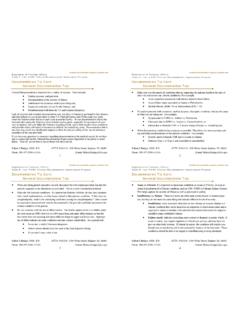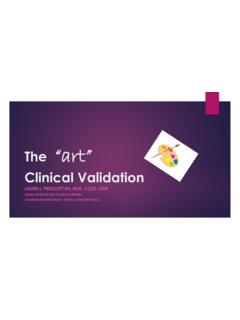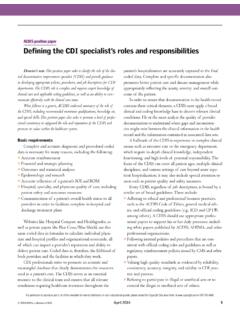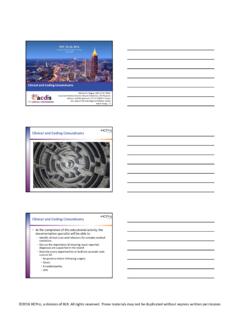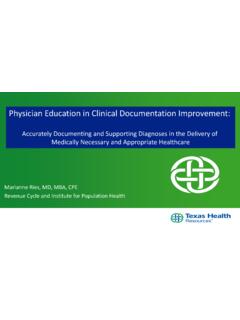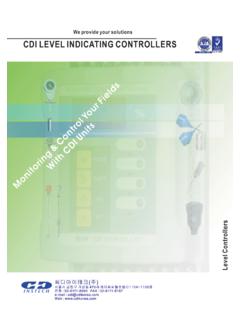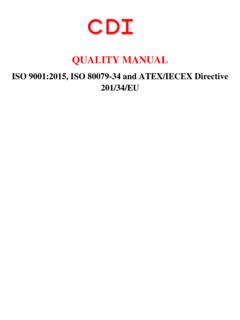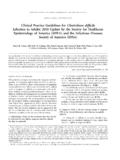Transcription of CDI “GOLDEN RULES”
1 cdi golden rules Please write legibly (unusable by anyone for anything if illegible!!) Please use the problem specific approach for all charting Please dictate all H&Ps, consultations, procedure notes, operative reports, and discharge summaries ON THE DAY OF SERVICE to the patient Please list ALL Diagnoses in D/C summary - Particularly CDI Queried Diagnoses! Please pay attention to CDS nurse queries - They are here to help you! Remember Present On Admission if an unrealized problem is discovered or realized later on in hospitalization and was present at admission Please write out all arrhythmia names and all hypo- or hyper- electrolyte -emias Consider alternative descriptors to labeling disease processes as post-op Do not use symbols and/or arrows to describe disease processes Possible, probable, suspect, likely, etc. OK w/ CMS but must be in D/C summary Acidosis - pH < , pCO2>45, HCO3<18, anion gap >12 Alkalosis - pH > , pCO2<28, HCO3>28 Acute Encephalopathy Definition: Global cerebral dysfunction in absence of structural brain disease.
2 Please consider this as opposed to altered mental status , confusion , delirium , mental status changes , acute psychosis , unresponsiveness Please document suspected cause such as hypertensive , post-ictal , anoxic , toxic/metabolic , uremia , alcohol/drug induced , hepatic , infectious (UTI, meningitis, prions, malaria, AIDS, rabies, neurosyphilis, etc.) Acute Exacerbation of COPD Is there acute or chronic respitory failure? Home Oxygen? Acute Myocardial Infarction - First episode of care? troponin > 99th percentile +sx Anemia GI bleed, GSW, epistaxis, etc. is anemia due to acute blood loss Please document that anemia as a separate problem from its cause *2 pt drop in Hgb after surgery is Drop in HCT - expected due to specific procedure BMI and Morbid Obesity document in chart if BMI 35 Chest Pain is a symptom (cause?)
3 -pleuritic, GERD, musculoskeletal, anxiety, angina, Cirrhosis: Caused by which virus, ETOH, Is there Hepatic Encephalopathy? Is there Spontaneous Bacterial Peritonitis? Is there Portal Vein Thrombosis? Are there Esophageal Varicies w/ Bleeding? Is there Ascites and/or Jaundice? Decubitus Ulcer Documentation must include Exact Location & Stage: Stage 1: nonblanchable erythema of intact skin Stage 2: partial thickness skin loss involving epidermis, dermis, or both Stage 3: full-thickness skin loss involving damage to or necrosis of subcutaneous tissue that may extend down to, but not through, underlying fascia Stage 4: full-thickness skin loss with extensive destruction, tissue necrosis, or damage to muscle, bone, or supporting structures ( , tendon, joint capsules) Diabetes Mellitus - Need type and control status: Type 1 , Type 2 , or secondary?
4 AND Controlled or Uncontrolled? uncontrolled = several in-house blood sugars > 200 OR HbA1c Please list all known diabetic complications (short or long-term) Excisional Debridements - Must be titled as Excisional Debridements 1) Specifics of wound site, location, & size 2) Depth debrided to in tissue layers 3) Removal of devitalized/necrotic tissue 4) Exact instrumentation used Hypertension - Accelerated or Malignant (BP 180/110 with intervention) as opposed to hypertensive urgency or emergency or crisis Pathological Fracture due to Osteoporosis - Did the fracture occur due to a ground level fall? Stroke v. TIA TIA - brief cerebral, spinal, or retinal ischemia without acute infarction (nothing on MRI) Stroke - neurological symptoms with evidence of stroke on neuroimaging Aborted Stroke - transient symptoms due to ischemia with normal MRI (look for t-PA) Syncope with collapse as opposed to REMEMBER TO DOCUMENT DIAGNOSES AND NOT SIGNS/SYMPTOMSMUST THINK IN INK!
5 !!IF YOU TREAT IT .. CALL DOCUMENTATION - 5 HEAVY HITTERS!Sepsis Definitions: Sepsis = SIRS plus suspected infection (pneumonia, cellulitis, device, etc.): SIRS = any 2 of these 4: - Temp > ( ) or < (36C) - Pulse > 90 - RR > 20 - WBC s > 12,000 or < 4,000 or WBC differential w/ > 10% bands Consider Sepsis due to UTI vs. urosepsis Use SIRS from a non-infectious source If SIRS without infection eg. Pancreatitis Severe Sepsis = Sepsis with evidence of end-organ damage Septicemia = Sepsis w/ bacteremia Bacteremia is a lab findingShock: Failure of circulatory system to maintain adequate blood flow Septic - Sepsis refractory to fluid resuscitation requiring pressors Cardiogenic - Decreased Is there an IABP? Is there a Dobutamine drip? Anaphylactic, Hypovolemic, or HemorrhagicPneumonia - Simple, CAP, HAP, VAP Due to suspected/causative organism(s) and/or Aspiration?
6 If the antibiotics are zosyn (or cefepime) and vanco - do you suspect GNR and MRSA? If the antibiotics include clinda/flagyl - do you suspect aspiration?Respiratory Failure: Acute, Chronic, Acute on Chronic Acute Respiratory Failure if resp distress but ICU and vent NOT necessary andpH & pCO2 > 50 or pO2 < 60 *(Sat <88%)* Chronic Resp Failure = Normal pH w/ high pCO2 on ABG and/or on home O2 Congestive Heart Failure Acute v. chronic, systolic v. diastolic v. both, right v. left ventricular dysfuntion CHF - Need cause and temporality: Cause = Systolic (EF 40 %) or Diastolic (normal EF) or both Temporality = Chronic or Acute or Acute on Chronic *Note: Still need to list EF at least once in chart for core measuresAcute Renal Failure/Acute Kidney Injury Serum creatinine increased by mg/dl over baseline in serum Cr x baselineChronic Kidney Disease (as opposed to CRI or CRF): GFR = >90 Stage I GFR = 60 to 89 Stage II GFR = 30 to 59 Stage III GFR = 15 to 29 Stage IV GFR = <15 (no HD/PD) Stage V ESRD = on dialysis
